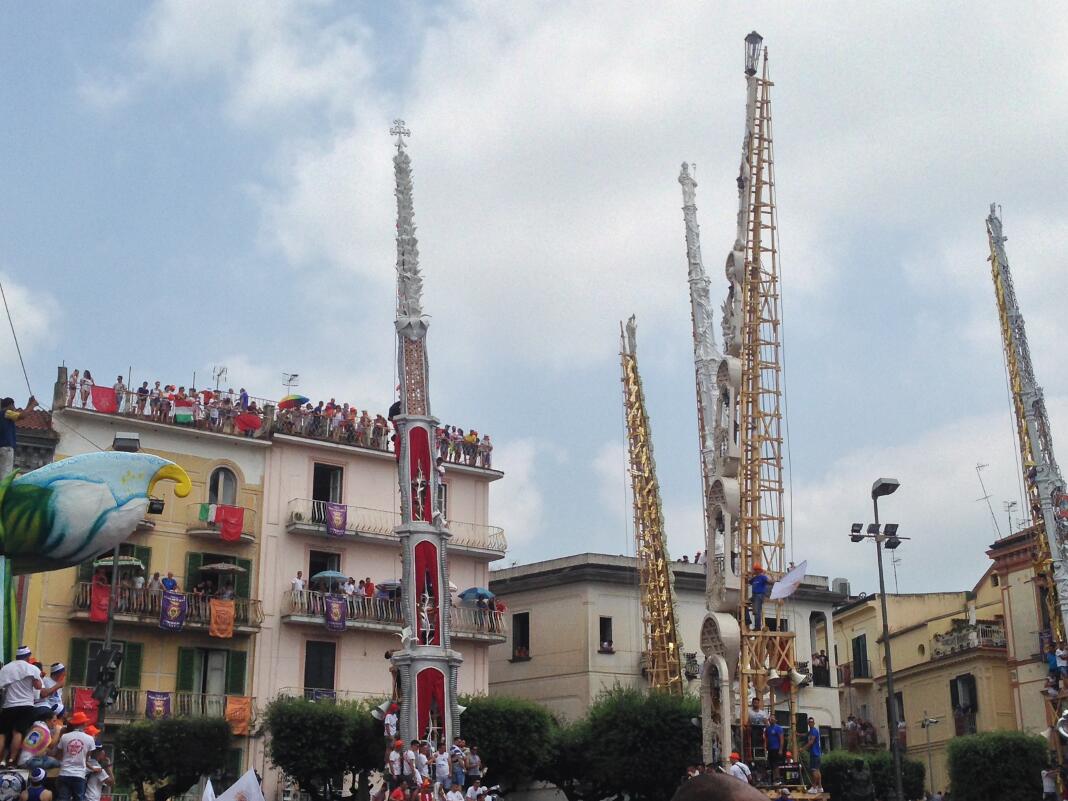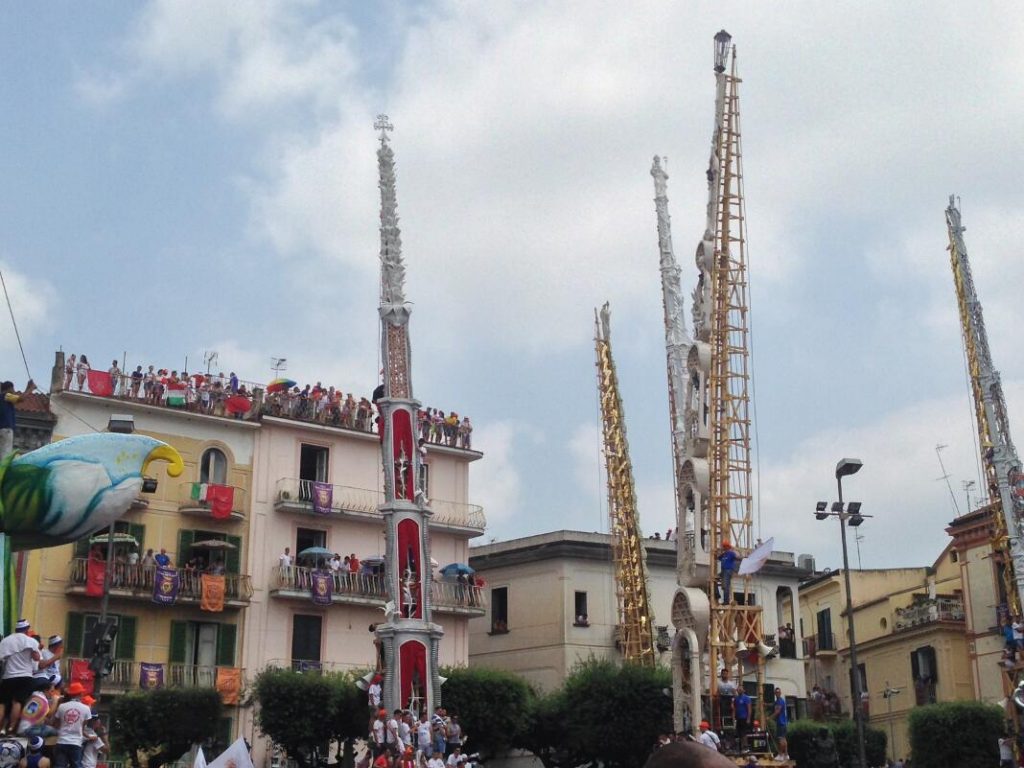Ostensibly, you can’t touch an “intangible”. We just did. And at a deep level. Ever since hearing about the 2013 UNESCO’s inclusion as Intangible Cultural Heritage of Humanity of Italy’s four Big Shoulder-Born Processional Structures, I’d set my sights on every procession, each structure (“macchina,” in Italian). My first? Viterbo’s astounding La Macchina di Santa Rosa. Palmi (Calabria) and Sassari (Sardegna) – hometowns of La Varia and the Candelieri processions – are treks from Umbria… But we made the late June Festa dei Gigli (“Festival of the Lilies”) in Nola (near Naples) – and we’re still recovering.
You have to slowly ease out from the emotional cyclone of days living the delirious nolana passione for the celebration of patron saint, Bishop San Paolino – and not just the living it, but hearing it! For days preceding the carrying of the Gigli – the Sunday after San Paolino’s feast, June 22nd (date of his death in 431 A.D.) – typical musica nolana surrounds you, enveloping Nola. That Neapolitan music with marching beat will set the rhythms for the carrying of eight four-ton Gigli, by teams of 120 – 140 men (la paranza), Sunday morning, then all the following night.
Music throbs in winding alleyways, palazzi courtyards, and the piazzas where the eight elegant carved gigli tower 25 meters above groups of musicians playing for jubilant locals dancing to the beating rhythms, clapping, waving scarves and fans, blowing whistles dangling around necks. All know the rhythms; they’ve grown up with that pulsing beat accompanying the moves of the eight Gigli on the Sunday of the Festa.
On that Sunday, each Giglio, a splendid sentinel (once of papier mache’, now of styrofoam base, too), rises on a wooden quadrilateral platform, encircled by seated musicians, all carried on the shoulders of the Giglio’s cullatori. Cullatori – “cradlers” – refers to the rocking movements of these men in harmony with the music, united with arms linked, following the directives of their four caporali at the corners of each giglio base. Caporali set the rhythms, directing the paces of the panting, grimacing – at times, moaning – cullatori swaying, prancing in unison to the beats of the band seated on top of their backs. Some cullatori, carrying the Gigli for decades, have backs deformed with mounded callouses, sported proudly.
La Festa dei Gigli ostensibly honors Nola’s 5th-century bishop, commemorating his return by sea from captivity by the barbarians, joyous nolani welcoming the arriving boat waving lilies (and la barca, too, will be in the midst of the Gigli on Sunday). But look again at those eight obelisks: clearly phallic. And this is summer solstice time, when the Romans bore homages to their deities for rich harvests to the temples: bound sheaves of grains, set alight – as the Gigli once were, for this festival’s roots are ancient.
And once again the pagan and Christian unite and blend harmoniously in Italy’s festivals of passione.
We lived la passione nolana thanks to Gianni. Red-haired young nolano engineer, Gianni now works in Tuscany but heads home for the Gigli, logicamente, as do New Yorkers we met of nolano descendancy – though none were cullatori– eager to reunite with their paranza. Like Gianni. He was home to embrace his Giglio – and the festival. And Gianni embraced us, too, right from his advice on choice of B&B to tips on best fish ristoranti, his favorite cafe’ and gelaterie, Nola historic sites, festive moments not-to-miss, how to take the guided walking tour of the Gigli – and where to be on Sunday morning as the Gigli entered the main piazza backdropped by the Duomo, where San Paolino is buried (eight elegant Gigli processional banners flanking his flower-laden altar).
By Sunday, we were in the throes of “Gigli passione.” When did it start?
Probably Friday night, joining Gianni and friends for a pre-festa dinner to the beat of the musica nolana, all up to dance, sing between courses. Nolano fervor was contagious We felt it during our one-hour guided walk with impassioned young Giulia from Giglio-to-Giglio (passing small, hand-crafted gigli in many Nola shop windows and cafes) – and while hearing the stories of Gianni’s uncle, once a caporale for his paranza.
Nola kept on embracing us: we visited Gianni’s home, his father welcoming us with his homemade nocino (walnut liqueur) and his mother, with typical Gigli sweets. In the Duomo, I saw children praying before the San Paolino altar in the Duomo, their father reaching up to reverently touch the silver bust of the Saint (carried in Procession during the festivities): “Thanks to him, I survived a car accident”.
And on Sunday morning walking to the main piazza where the eight Gigli and la barca di San Paolino would soon converge, peaking emotions, explosive enthusiasm surrounded us. We passed piazzas with Gigli in the center, encircled by dancing, singing, clapping nolani in paroxysms of delirium.
In Piazza Giordano Bruno, la Festa dei Gigli hit us like a tsunami wave, washing us away: indescribable the emotional shock of first sight of a Giglio lifted up by 120 linked men, prancing to the rhythms of the band playing on the platform on their backs. Pino gasped, then grinned, then clapped. I just furtively rubbed away unexpected tears slipping down my cheeks.
Gianni, you shared so much with us – but nothing could possibly prepare us for the rhapsody of Gigli emotions.
We were far more than just “touched” by this ”Intangible.”

